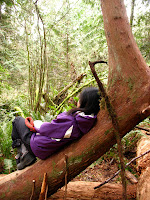 The year is wrapping up. Both cohorts have finished their last weeks of solo teaching. The only things that lie between us and graduation are a week of team teaching and presenting our independent study projects, non-profit management projects, and portfolios.
The year is wrapping up. Both cohorts have finished their last weeks of solo teaching. The only things that lie between us and graduation are a week of team teaching and presenting our independent study projects, non-profit management projects, and portfolios.In these last couple weeks, many of us have been doing some final reflections on what this year has meant to us. We have turned in official assignments to our instructors and mentors in which we have reflected on our growth as an educator, but we have also been chatting casually around the Commons and over cups of iced chai teas at the Treehouse Café down the hill about how much we have grown in all realms of life this year. Although everyone is taking their own unique lessons from their IslandWood experience, many of us feel like we have grown monumentally as educators, members of a small community, and personally.
As educators we have been pushed to try approaches we've never tried before, worked with kids who have had life experiences that make it very difficult for them to be in a new environment like IslandWood, and debriefed our experiences, both successful and unsuccessful a million times with our peers, mentors, and instructors to seize all the possible opportunities for growth.
As members of a small community, we have had to figure out how to be with the same 29 people practically 24/7. We live together, we eat together, we work together, we take classes together, and we socialize together. We've been in quite the IslandWood bubble all year, which has brought its fair share of frustrations, but more important are the laughs and the compromises and the ways we have learned to understand one another. Even after long days of teaching and very little sleep, we have learned to love each other despite our quirks and flaws and to be patient with one another as we all try to figure out our lives.
And even with the due dates for our big projects looming and a long year of work and growth on our backs, we still find time to jump out of the bubble and savor the occasional ice cream cone at Mora's in Winslow or dance to groovy beats at the Folklife Festival in Seattle.


















